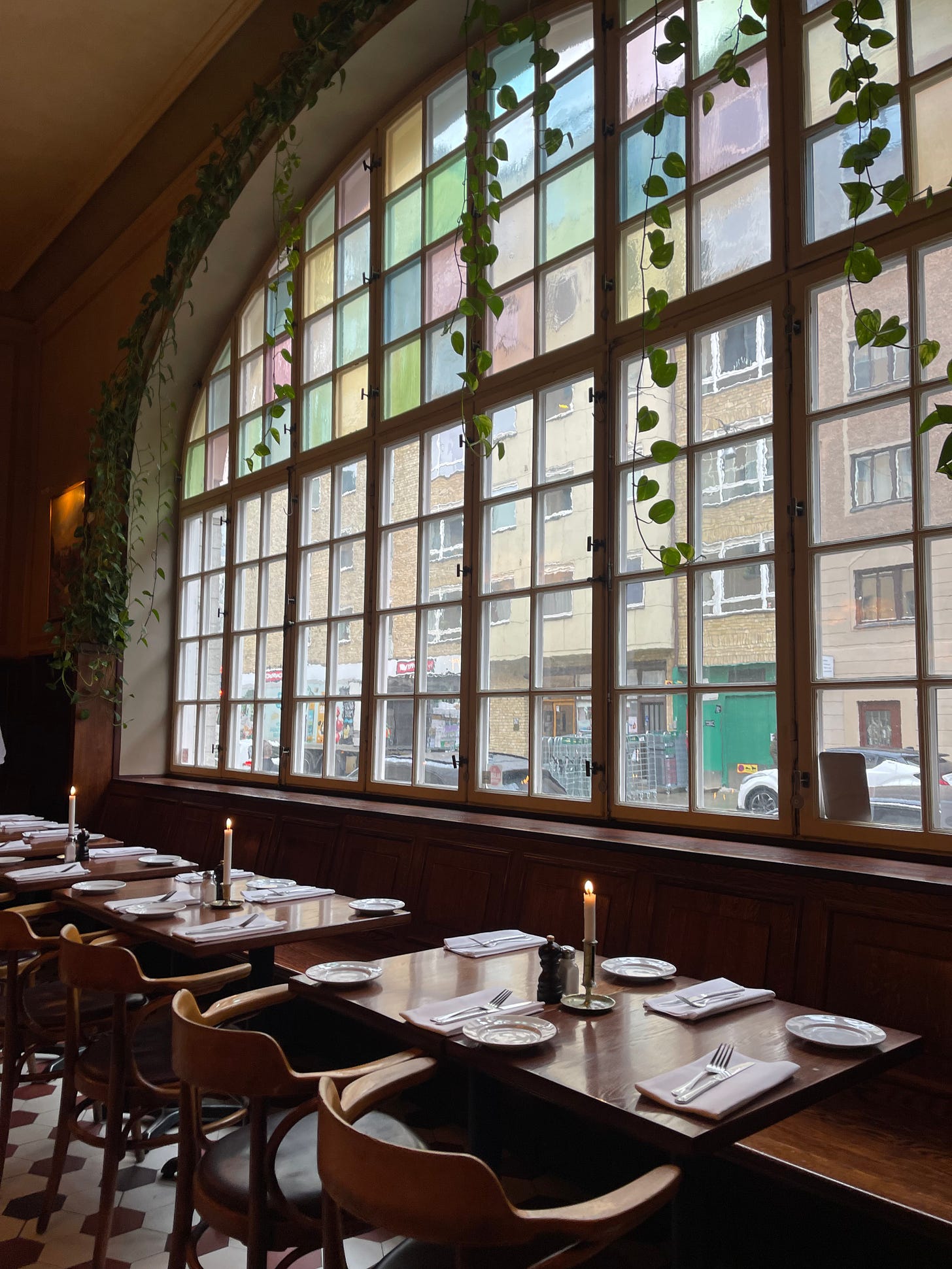the latte letters: stockholm
swedish vocabulary, what hides in the details, and the joy of having thumbs
Dearest friend,
I like knowing how to open doors. There’s comfort in the authority of knob-turning, in maneuvering myself through a logical layout, in being a mammal with thumbs.
When I boarded the Arlanda Express at the Stockholm airport, I found myself trapped in the first carriage of the train—I couldn’t figure out how to open the door between compartments.
The door wasn’t really a door at all, but a shifting wall of glass. The see-through element made it all the more intimidating to pass through, knowing a potential audience sat to watch me on both sides. No buttons glowed on either side of the barrier, and no handles either. How the hell do I open this thing?
After twenty seconds of a failed investigation, I gave up and slunk quietly into an empty seat, praying that I wasn’t stealing someone’s spot in what appeared to be first class. The ticket-checker came to my seat, a too-enthusiastic smile plastered on his face to greet passengers like me, and I opened with, “I don’t think I’m in the right place,” limply raising my ticket receipt towards him.
He promptly scanned the barcode. “You are,” he said, and when I smiled and laughed with relief, he’d already moved to scan my neighbor’s ticket.
This was the first of many signs that I had much to learn about Scandinavia, Europe, and travel in general. After a year of buying Ryanair flights like one collects trading cards, always trusting that I’d be able to navigate whatever city I found myself in, I found myself nervous for the first time since Athens. It wasn’t just Swedish design that confused me: the cashier at the Arlanda airport Pressbyrån (a regional convenience store chain) was an expressionless stone wall to each joke, laugh, and smile I extended while purchasing my train ticket—though he did tease me for bringing krona to a generally cashless country.
Cecelia met me at the train station, and noted in a tight hug that she recognized my hair before my face. I was so happy to see her: it’d been more than a year since I saw my good friend last, and I felt increasingly out of place.
Thankfully, she had the perfect first stop in mind. To get there, we walked and talked through Stockholm’s city center, along the sparkling Baltic Sea, through crowds of fashionably-dressed passerby’s, and past stunning baroque facades.
“The first Swedish word that I’ll teach you on this trip, I think you’ll find to be a very important one.” Cecelia pointed to the words painted above the doorway of the tall white building before us.
Bagariet, it read. The bakery.
Our first of many bakeries, Stora Bagelri in Östermalm wowed me with its Salmon Smörgås, slices of rye bread topped with horseradish, cucumber, and incredibly rich lox. Behind Cecelia’s seat, I watched bakers cut careful shapes from the dough they laminated while joking with the barista; warming an already cozy environment.


Watching these pastries be made, we couldn’t help but order one—we split a Kardamombullar. Cardamom, the star of this bun, is well-loved in Scandinavia, and has been since the 1400s; it’s warm, aromatic, and unmistakable in flavor.
If cardamom isn’t your thing, Sweden is also the birthplace of kanelbullar, what we Americans know and love as the cinnamon roll. I’d recommend these buns to anyone and everyone alive. Kanelbullar are distinct from their famous descendant; rather than topped with a thick white frosting, the pastry is brushed with a translucent, sweetly-spiced glaze that moistens every bite. Pearl sugar adds what I never knew was missing in cinnamon rolls: a crunch factor.
While my favorite kanelbullar came from Södermalm’s Svedjan Bageri, you can find them almost anywhere. They’re deeply beloved: National Cinnamon Bun Day (Kanelbullens dag) is observed every October 4 in both Sweden and Finland.
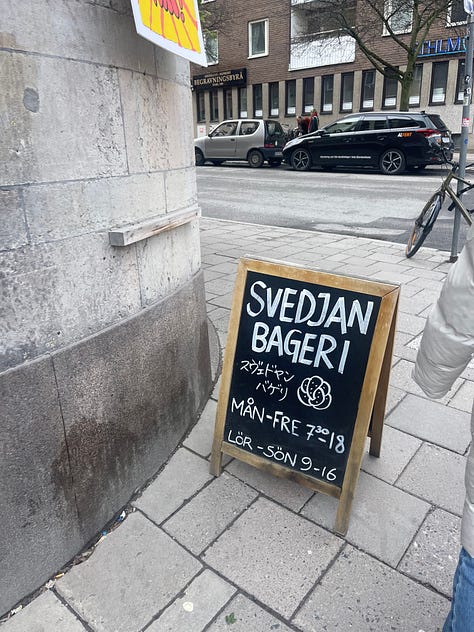


Cinnamon buns are celebrated far more than once a year, however—pastries and coffee are woven into Swedish life through a vital ritual.
Fika
You might’ve heard this one before. Fika is a coffee and pastry break taken multiple times a day, usually between 10 and 3 o’clock. This habit fosters cohesion between friends, family, and coworkers, and acts as a pause beyond lunch to relax, re-energize, and savor.
Fika is even built into certain Swedish contracts—it’s more than a coffee break, it’s a detail that can’t be overlooked.
For tourists like me, fika is a fantastic excuse.
Stockholm’s cafés exceeded all my expectations, both in their pastries and their unforgettable atmospheres. Though the lattes I had were, ironically, nothing to write home about, the drip coffee was second to none. The best coffee I tasted came from Café Stories.
A rooftop café in central Stockholm’s Kulturhuset, Cecelia and I partook in their hazelnut-apple roast, a Chokoladbullar, a passion fruit tart, and personal reflections while watching pedestrians dodge pigeons in the rainy square below.
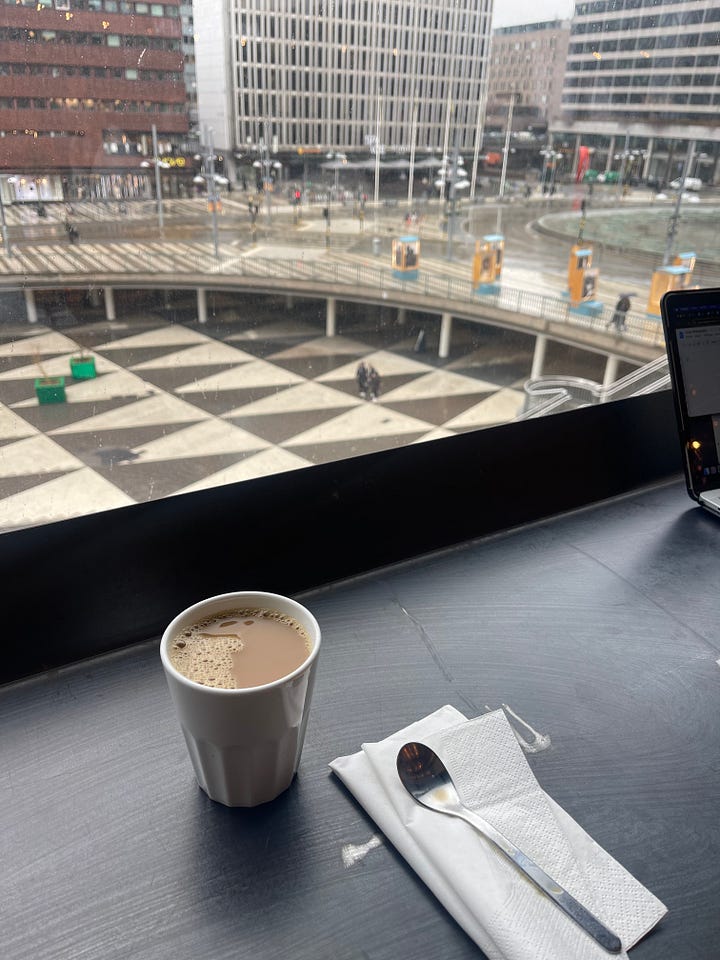
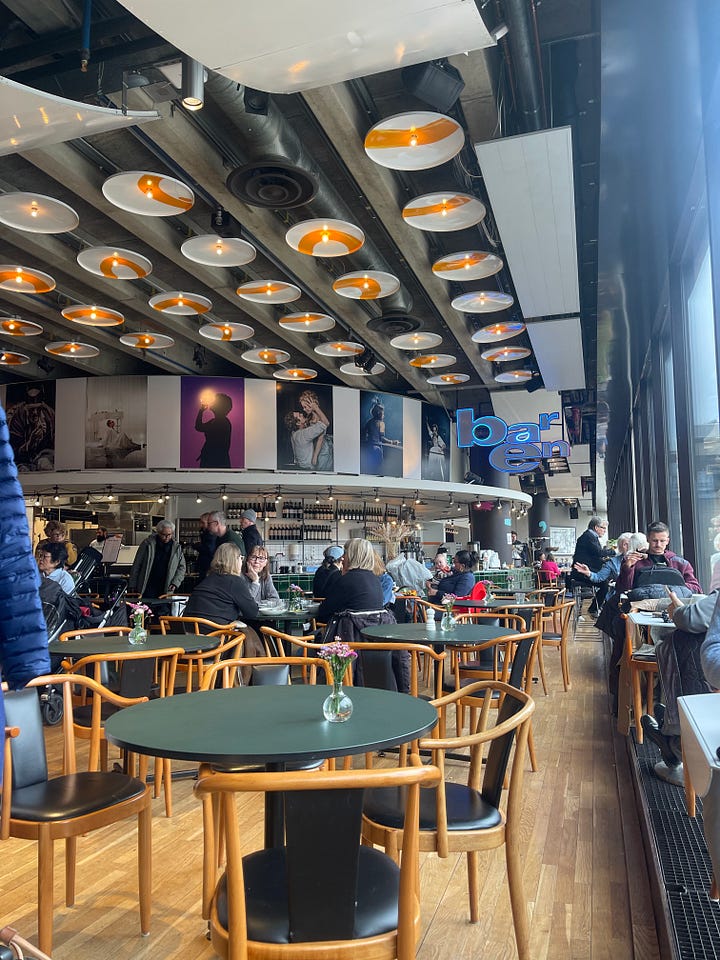
Fika comes especially in handy after a long day of on-foot sightseeing. Following a visit to the spellbinding Vasa Museum, the Rosendals Trädgårdskafé stunned me further based on its setting alone — drip coffee, sandwiches, and baked goods from a bakery next door are served inside a greenhouse. A greenhouse! We enjoyed another gravlax sandwich while surrounded by candles, lively conversation, and well-mannered birds.


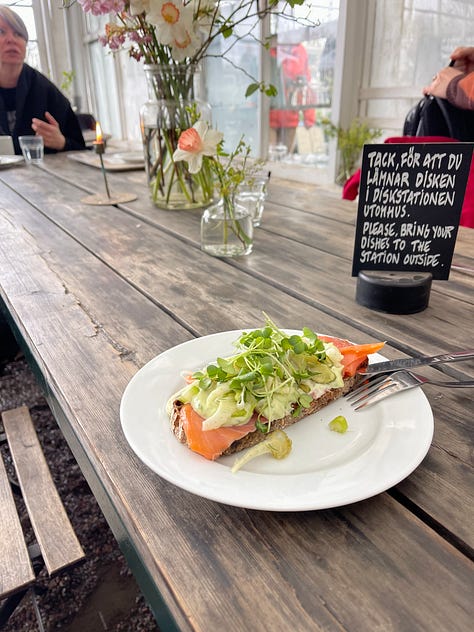
Cecelia knew all the best cafés, and I knew well before coming that she’d know them. She always thrills me with her perspective—she’s fastidious, detail-oriented, and regards everything with balance—I suppose that’s why Stockholm is so well suited for her. My trust in her judgement removed all my anxiety from being in such a new and different place; I knew she’d catch any important details I might miss.
Latte Pappas
Leaving Svedjan post-kanelbullar, Cecelia asked me, “Have you noticed how many dads are walking around with strollers?”
I hadn’t. Possibly the most obvious detail I hadn’t caught while walking through Stockholm, I suddenly started seeing them everywhere. Dads were jogging with strollers, carrying strollers up and down flights of metro stairs, and sitting with stroller-bound babies in restaurants and coffee shops. Cecelia told me they’re affectionately known as latte pappas.
As their namesake suggests, they’re often spotted out and about with a latte in hand, or enjoying a fika with their children in a coffee shop. Considering each Swedish parent gets 240 days of paid parental leave (90 of which are lost if they aren’t used) there’s plenty of incentive for fathers to take a day off.
Watching yet another latte pappa pass us by on the street, I considered what the phrase really meant—having so many paid days for parental leave says a lot about a country, but where those days are spent says even more.
Lägom
After a dinner of Swedish meatballs, Cecelia and I took the metro back to her apartment. On the journey, I couldn’t stop thinking about how beautiful every space we entered was, especially the restaurant we had dinner at, called Pelikan.
Most interiors—cafés, restaurants, bookstores, thrift shops, etc—looked something like this to me. Was it the constant presence of candlelight that made me feel so cozy? The checkered floors? Huge windows? The wooden furniture?
Cecelia labeled the Swedish cultural mindset when I shared my curiosity, using an untranslatable term. Lägom equates to ‘not too little, not too much.’
As Cecelia described it, Swedes strive for balance in everything they do, resulting in a mindset that cringes at flexing, but upholds high social standards. It speaks to a lifestyle “based on social awareness, moderation and sustainability.” Lägom means striving for success rather than perfection. It means indulging in candy once a week, taking breaks to enjoy not-too-sweet pastries, and prioritizing minimalist yet striking design. Not over the top, but not underwhelming.
Nyttokonst, or ‘useful art’, echoes this appreciation of balance. It’s a mid-century Swedish concept that married utilitarian objects with artistic beauty. It carries through to the modern day: so many of Stockholm’s spaces are equally functional and visually appealing.
Tiny elements make each simple space welcoming: candles, mushroom-shaped lamps, and/or new-age chandeliers light every interior. Exteriors, if not modern, are Swedish baroque, gothic, and classicist; often well-maintained and stark in their presence. Each place we entered felt comprehensive, accommodating, and intentional.
Even Stockholm’s metro stations are functionally atmospheric: each one showcases bold and distinct art styles, creating a completely unique place to wait for the next train. As Cecelia described it: “If there’s a space you have to exist in every day, why not make it pleasing to the eye?”



My stay in Stockholm felt like one big celebration of detail. This is in part to how Cecelia and I have fun: by discussing our surroundings and dissecting the features of any room, meal, artwork, or person to understand what makes them what they seem to be.
If there was any place in the world tailored to our hangouts, it’d have to be here: where coffee and community are firmly interwoven, where saunas are beloved, and where conscientiousness is the ideal lifestyle.
When I finally boarded the train to Arlanda airport, my eyes barely dry since leaving Cecelia’s flat, I entered the first compartment. There was no good place to sit, and I found myself face to face with the tricky glass door yet again.
A ticket checker passed by, approached the door, and waved her hand at its highest point. The barrier slid to the left for her immediately, and she walked right through.
I confidently followed her lead with a renewed respect for Swedish design. No detail can be underestimated. Sometimes, we won’t see these key details until they’re pointed out to us.
w/ love,
Constanze




